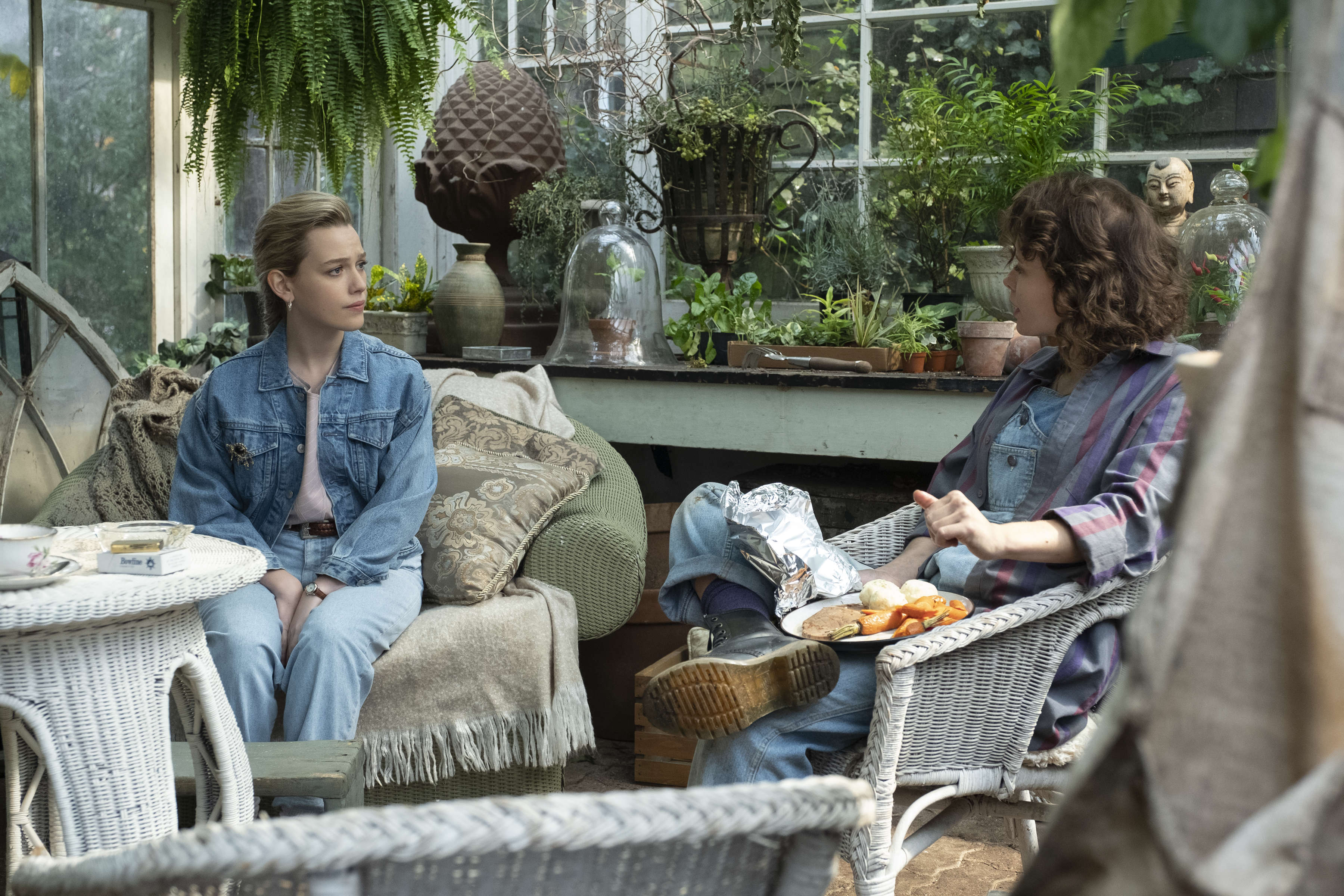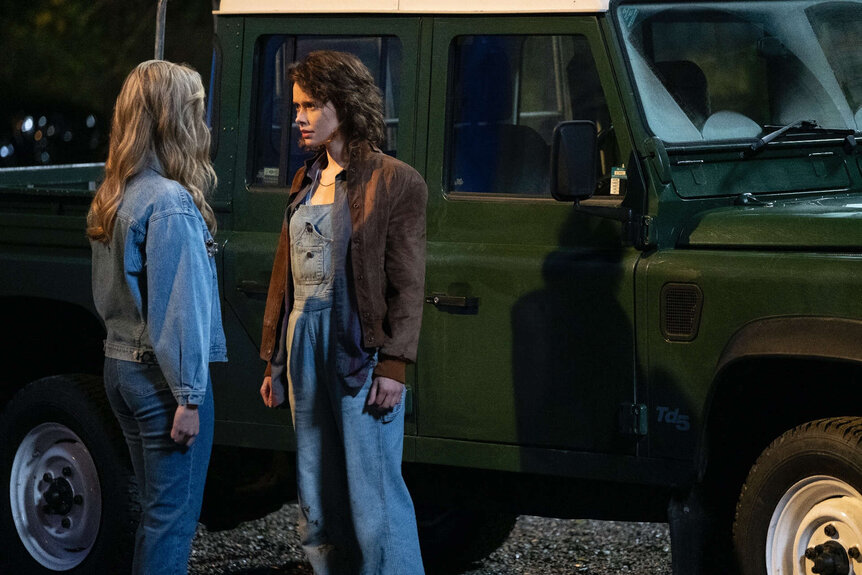Create a free profile to get unlimited access to exclusive videos, sweepstakes, and more!
The Haunting of Bly Manor offers a subversive love story against the backdrop of a Gothic romance

From the moment we are introduced to the tale of the mysterious Bly Manor — a recounting set 20 years from the "present day" where it is being told to an engaged couple on the eve of their wedding — it is clear that the yarn being spun for them (and us, by extension) from the then-enigmatic narrator (played by Carla Gugino) is more than a typical ghost story. Indeed, the overarching narrative of Mike Flanagan's latest creation for Netflix in his horror anthology series, The Haunting of Bly Manor, possesses all of the familiar trappings of Gothic fiction — but over the course of the show's nine episodes, it's clear that the setting, the motifs, even the familiar character archetypes of this genre are all serving as the backdrop to a more subversive story.
Warning: Spoilers for The Haunting of Bly Manor.
The origin of Gothic romance — and Gothic fiction as an overarching literary subgenre — dates all the way back to 1764, when English author and art historian Horatio Walpole, 4th Earl of Orford, published The Castle of Otranto, which was given the subtitle of A Gothic Story in its second edition. Walpole had initially disguised his book as a medieval romance, but when the book was reprinted and essentially repackaged as a romance with superstitious elements, wonder and terror alike, it was critically rejected as a lesser work. Still, the merging of the medieval and the modern proved to be a formula for success that others soon wanted to emulate, and would pave the way for authors such as Ann Radcliffe, who introduced the gloomy, temperamental male figure who would come to be largely associated with Gothic romance. Later, the wave of Romantic poets in the early 19th century had the biggest impact on many of the tropes and elements of Gothic fiction that we most remember today; the moody and reclusive male archetype that was dubbed the "Byronic hero" was largely inspired by the antics of the poet Lord Byron himself. But the Romantic movement also offered one of the most significant Gothic fiction works in Mary Shelley's Frankenstein; or, the Modern Prometheus, a book Shelley was partially inspired to write from a ghost-story writing competition Byron hosted at a villa on Lake Geneva during the summer of 1816.
From the Victorian era on, Gothic fiction dwindled in popularity, but several authors continued to write stories that would both reinvigorate and revamp the long-running genre. Edgar Allan Poe was one such name who combined both the horrors of the psyche and the element of decay among physical structures and mental capacities alike. But arguably, it was the Brontë sisters who informed much of the feminine perspective in Gothic fiction around this same time — it's impossible not to think of the genre without considering how both Wuthering Heights and Jane Eyre (published in the same year of 1847) took inspiration from authorial influences that came before them while also emphasizing newer themes of female repression, the rejection of the patriarchy, and the often tragic consequences faced by the women who attempted to subvert established gender roles.
Within 50 years or so, Gothic fiction would experience a resurgence as a literary form at the turn of the century, moving away from rural settings to reflect a growing industrial society, with stories like Robert Louis Stevenson's Strange Case of Dr Jekyll and Mr Hyde, Oscar Wilde's The Picture of Dorian Gray, and Henry James' The Turn of the Screw among some of the most popular titles. The latter was first published in serial format in Collier's Weekly magazine beginning in January 1898 and has since gone on to become adapted several times over for radio, film, theater, and television — with The Haunting of Bly Manor pulling both from James' novella as well as several other works by the same author that had never been adapted before.
Bly Manor definitely draws on some of the most recognizable tropes in Gothic romance — the strange and long-standing house that au pair Dani Clayton (Victoria Pedretti) ventures to in order to care for the two Wingrave children automatically sets the scene in terms of what the audience should expect. Even Dani herself bears all of the hallmarks of a classic Gothic heroine, the young and seemingly innocent woman who is kind, compassionate and virtuous, later revealed to be fleeing something — or someone — whose origins are also slowly divulged over time. She is haunted by a past that she cannot escape no matter how hard she tries, a face that hovers behind her every time she looks in the mirror. Dani's ghost is not just a manifestation of her own guilt, or a soul tethered to a pair of seemingly indestructible glasses that she clings to long after the sudden and devastating death of her fiancé; it also represents the side of herself that she has been repressing for arguably most of her life, the same side she finally began to come to terms with the night she decided to break off her engagement, and the same night Eddie died.
But even as the specters of the past linger within and without the manor, their souls held captive by the eternal grief of Viola, the faceless Lady of the Lake (Kate Siegel), the promise of something new begins to blossom. When Dani first encounters the gardener at Bly, Jamie (Amelia Eve), there's the hint of something more between them, an interest that begins to bud and develop much like the roses Jamie protectively tends to. Their evolution on-screen is singular, an arc that does not conform to all of the typical beats of Gothic fiction. Those are reflected much more clearly in the doomed relationship between previous au pair Rebecca Jessel (Tahirah Sharif) and Sir Wingrave's employee Peter Quint (Oliver Jackson-Cohen), the latter of whom bears all of the characteristics of the selfish, scheming, and predatory male archetype both in life and well after death. By comparison, Dani and Jamie are the heart-warming outliers of the narrative because their romance survives, and endures, beyond the walls of Bly Manor. Even after Dani makes the ultimate sacrifice in allowing Viola to possess her body, thus freeing all of the spirits who have been trapped throughout the centuries, the two women still attempt to spend what years they might have with each other — loving one another openly and unapologetically.
In the end, their story is not a tragedy, not truly; Dani's return to Bly Manor in order to fulfill her destiny and take up the mantle as the new Lady of the Lake is not a punishment for any transgressions, but rather a decision of her own making that she embraces in order to spare the people she loves. When the Storyteller — who is finally revealed to be an older Jamie — concludes her tale, it's the culmination of her efforts to keep Dani's memory alive in the children who have grown up and largely forgotten the terrible events that transpired at Bly Manor all those years ago. Even the very last image of the entire series serves as proof that Dani has never left Jamie's side in spite of the fact that the other woman can't see her — a different kind of haunting, but one that serves as a testament to the power of their love.
Yearning, longing, repressed desire — these are all emotions that permeate the fabric of a Gothic romance. The difference here, in this modern adaptation of a classic story, is who gets to experience them, and who the romance ultimately serves. And considering the long-standing history of what the genre often emphasizes and gives weight to, the main love story of The Haunting of Bly Manor is rendered that much more defiant in the telling of it — even if, like the salient moonflower, it only bloomed for a short while.



























